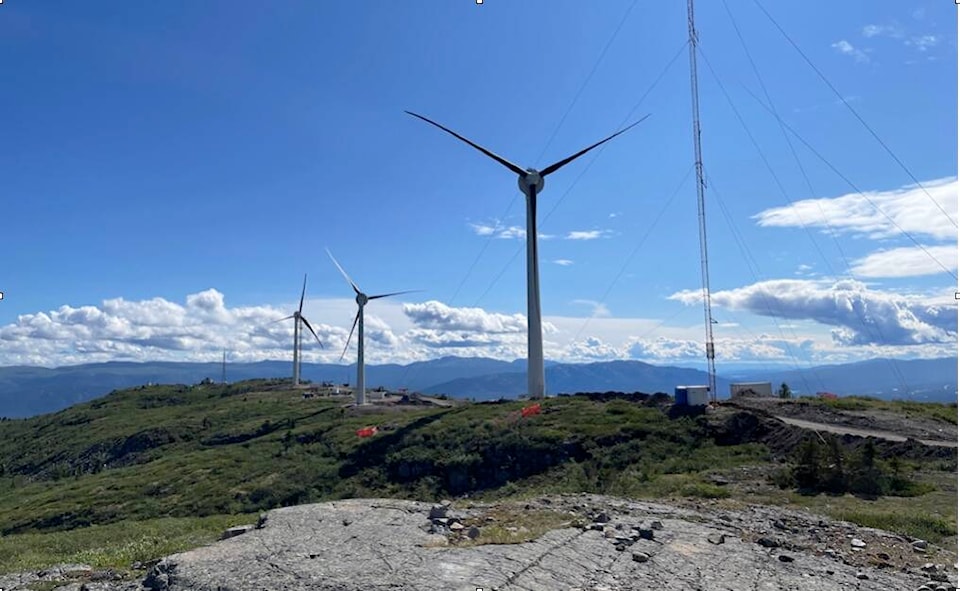The blades on the new wind turbines in place on Haeckel Hill overlooking Whitehorse will be turning in the coming days. Speakers at an Oct. 3 celebration of the turbine project’s completion made it clear that although the towering turbines went up in a matter of weeks, it took years of groundwork to get to that point.
Eagle Hill Energy Limited Partnership, the organization that will operate the four-turbine wind energy project, is a wholly-owned subsidiary of the Kwanlin Dün First Nation’s (KDFN) development corporation Chu Níikwän LP. It draws its name from the Kwanlin Dün name for Haeckel Hill: Thay T’äw which means “Golden Eagle Nest” in Southern Tutchone.
“Long ago, cultural knowledge shared by elders told of how Kwanlin Dün citizens have harvested energy from the land and water for the people’s needs for thousands of years. Based on those traditional values, Kwanlin Dün continues that important relationship with the land and water to create energy our communities use year-round but in a new and responsible way,” said KDFN Chief Sean Smith.
He expressed pride in what the project will provide for years to come.
The project is being hailed as the first 100 per cent Indigenous-owned wind energy project in Canada’s North. Les Wilson, Chu Níikwän’s director who also sits on the Eagle Hill Energy board, said the turbine project is on time and on budget. They are expected to be generating power by the end of October.
Also discussed was the energy the project will produce: enough for the annual demands of 650 Yukon homes over the next 20 years. Over its entire lifetime, the project is expected to generate energy equivalent to the burning of 40-million litres of diesel fuel. According to the territorial government, this will keep 115,000 tonnes of greenhouse gas emissions out of the atmosphere.
Many Whitehorse residents saw the silhouettes of the new wind turbines rising from the top of the hill as they were constructed in July while others saw the enormous blades and sections of the turbines’ structures being trucked to the hill.
Attendees at the Oct. 3 event, held at the Kwanlin Dün Cultural Centre in Whitehorse, were told about the ways the wind turbines’ design were adapted to the northern climate: Taller turbines with longer blades to access more of the wind and de-icing technology built into the blades to stop ice from inhibiting power generation. Wilson noted the importance of having turbines that can work well in the frigid conditions of a Yukon winter, as meteorological data shows the winds in the area are at their most powerful and consistent in the winter months. The cold months are also when the Yukon experiences its greatest energy demands.
The components for the turbines had a long journey; information circulated following the Oct. 3 event noted that the turbine pieces were shipped from the Netherlands to the Port of Stewart in British Columbia before they could be trucked to their final site. Road upgrades and concrete foundations had to be constructed last year as preparation for the turbines’ arrival.
Work to bring the turbines to the top of Haeckel Hill began long before the pieces arrived on the ship from Europe. Speaking at the Oct. 3 gathering, former KDFN chief Rick O’Brien described initial conversations about bringing a new wind-power project to the area at a conference in Vancouver years ago. Steps preceding the installation of the turbines included the installation of a facility to collect wind data on the hill and new policy by the Yukon government allowing groups other than existing utilities to generate electricity for the Yukon grid.
The project’s total cost was $29.8 million with a significant portion of that coming from federal government funding programs. The territorial government also recognized the $2 million worth of in-kind work that Eagle Hill Energy LP put into the project.
“This project signifies the potential for working with our natural environment, and to create a sustainable future,” said Yukon Energy, Mines and Resources Minister John Streicker.
The minister called the project an important part of energy security for the Yukon and the transition away from fossil fuels.
Yukon MP Brendan Hanley also sent a statement to be read lauding the project.
Unveiled on Oct. 3 alongside the completed turbines were a pair of legacy projects.
Eagle Hill Energy LP director Malek Tawashy presented Yukon University provost and vice-president academic Shelagh Rowles with a $20,000 contribution to go towards land-based education initiatives. Tawashy said the contribution represents a reoccurring annual scholarship to make more land-based opportunities available for students.
Rowles said the money will benefit many students regardless of their identity or what university program they are enrolled in. She highlighted the flexibility with which Eagle Hill Energy LP offered the contribution, and said it could go to a variety of equipment and materials for learning activities. It could also support students who want to participate in on-the-land learning by offsetting lost wages or costs for travel or child care.
Those in attendance at the Oct. 3 event also saw an early preview of The Winds Over Whitehorse Thay T’äw Kwändür, an illustrated children’s story containing oral history from a KDFN elder regarding the hill where the wind turbines are now in place.
Contact Jim Elliot at jim.elliot@yukon-news.com
